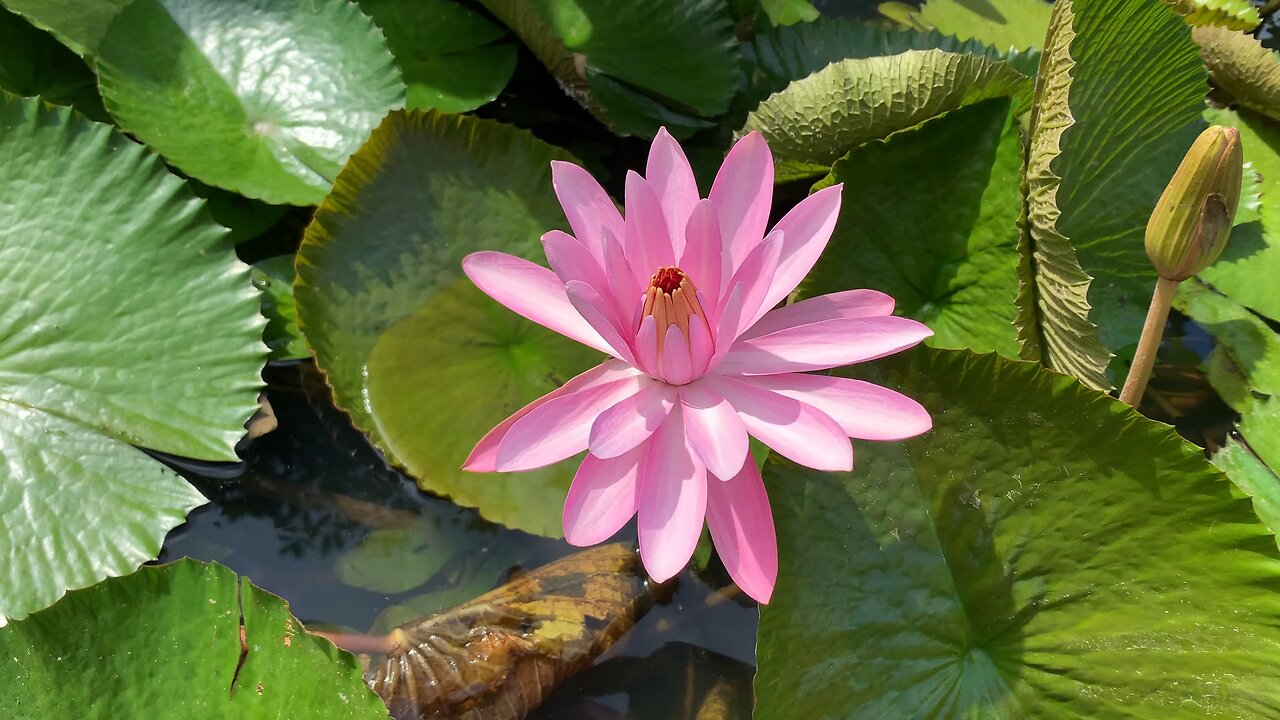Premium Only Content

"Serenity in Bloom: The Elegance of the Pink Water Lily"
Pink water lily (Nymphaea species) floating on the surface of a pond.
### 1. **Botanical Description**
- **Appearance**: The water lily has large, round, green leaves that float on the water's surface. These leaves are typically flat with smooth edges and can vary in size depending on the species. The flower is the highlight, with multiple layers of delicate, soft pink petals that open wide in the sunlight.
- **Flowers**: The flower in the image is a stunning pink, with numerous petals forming a star-like shape. At the center of the bloom, the stamens are visible, which are often a deeper shade of pink or yellow, adding contrast to the lighter petals.
- **Growth Habitat**: Water lilies are aquatic plants that thrive in freshwater environments like ponds, lakes, and slow-moving streams. They require calm, still water to flourish.
### 2. **Ecological Significance**
- **Habitat**: Water lilies provide essential habitat for a variety of aquatic species. Their large leaves offer shade and shelter for fish and other aquatic organisms, helping to maintain a balanced ecosystem.
- **Oxygenation**: The presence of water lilies can help oxygenate the water, which is beneficial for the overall health of the pond or water body they inhabit.
### 3. **Cultural Significance**
- **Symbolism**: Water lilies are often associated with purity, peace, and rebirth in various cultures. They have a deep connection with spirituality in many traditions, particularly in Eastern cultures where the lotus, a close relative of the water lily, holds significant religious importance.
- **Art and Literature**: Water lilies have been a popular subject in art, most famously depicted in the paintings of Claude Monet, who created a series of works inspired by the water lilies in his garden.
### 4. **Growth and Care**
- **Planting**: Water lilies are usually planted in pots that are submerged in water. They need about 6-8 hours of direct sunlight daily to bloom profusely.
- **Water Depth**: These plants prefer a water depth of about 12 to 24 inches. If planted too deep, they may not flower as effectively.
- **Maintenance**: Regular maintenance includes removing dead leaves and flowers to prevent decay in the water, which can affect the health of the plant and the water quality.
### 5. **Varieties**
- **Hardy Water Lilies**: These are more tolerant of cold weather and can survive in temperate climates. They typically bloom during the day.
- **Tropical Water Lilies**: These prefer warmer climates and often have larger, more vibrant flowers. Some tropical varieties are night-blooming, offering a different type of beauty after dark.
### 6. **Interesting Facts**
- **Pollination**: Water lilies are pollinated by insects, and their flowers are designed to attract them with their vivid colors and sweet fragrance.
- **Adaptations**: The leaves of water lilies have a waxy coating that helps repel water, keeping them dry and preventing the plant from becoming waterlogged.
Water lilies are not only visually stunning but also play a crucial role in their ecosystems. They are relatively easy to grow and maintain, making them a popular choice for water gardens around the world. The pink water lily in your image is a classic example of this plant's elegance and tranquility.
-
 DVR
DVR
I_Came_With_Fire_Podcast
14 hours agoNO EPSTEIN FILES | AI Marco Rubio | China Attacks Germany | Cloud Seeding in TX & NM?
24.8K9 -
 3:14:05
3:14:05
Geeks + Gamers
5 hours agoGeeks + Gamers Play- MARIO KART WORLD
36.4K -

Alex Zedra
5 hours agoLIVE! Scary Games tn!
33.2K1 -
 47:26
47:26
Friday Beers
8 hours ago $1.46 earnedWe Drank 12 Beers & Found the Zodiac Killer
35.2K2 -
 1:02:33
1:02:33
Mike Rowe
1 day agoCan We Fix The American Diet? | Jillian Michaels #441 | The Way I Heard It
22K17 -
 1:08:23
1:08:23
VapinGamers
5 hours ago $0.97 earnedDune Awakening - Community Spice and Everything Nice Game Night - !rumbot !music
17.1K -
 3:32:02
3:32:02
Fragniac
6 hours ago🔴 MAKE FPS GREAT AGAIN❗
14.9K -
 3:05:48
3:05:48
RCAM
5 hours ago $0.81 earnedMarvel Rivals | Expedition 33 | Gaming on Rumble | @SELFMADEGGS
13.1K3 -
 4:28:00
4:28:00
Razeo
5 hours agoEp 3 Batman Arkham City 1st playthrough – The Bat signal calls, Gotham’s Hero Rises Again!
10K1 -
 8:50:56
8:50:56
Dr Disrespect
16 hours ago🔴LIVE - DR DISRESPECT vs TARKOV - NEW HARDCORE WIPE (DAY 1)
149K9